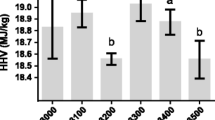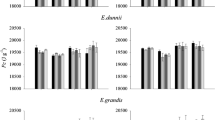Abstract
The energy stands of fast-growing tree species and crops are a prospective resource of renewable energy to the future. The paper focuses the assessment and comparison of the thermal properties of selected species of fast-growing trees (Paulownia tomentosa, Salix viminalis clone Tora, Populus × euramericana clone MAX 4) and energy crops (Sida Hermaphrodita, Arundo donax, Miscanthus × giganteus), as well as ash content (mass%). The following fire and thermal and properties were tested: spontaneous ignition temperature, gross caloric value, heating value. Besides those parameters, the elemental composition and ash content of the samples tested were analyzed. The results showed the energy crops to be much more effective for energy production than the energy trees. It is mostly due to higher yields harvested in a relatively short time, increased share of fiber, as well as higher energy efficiency. The highest heating value (energy potential) in case of energy crops showed Miscanthus × giganteus (16.29 ± 0.14 MJ kg−1), which had the lowest ash content (2.67 ± 0.08 mass% on average). The highest heating value in case of fast-growing tree species showed Paulownia (16.40 ± 0.18 MJ kg−1), which also had the lowest ash content (0.75 ± 0.05 mass% on average), while the Populus had the highest one (2.58 ± 0.24 mass% on average).
Similar content being viewed by others
References
Dipesh KC, Blazier MA, Pelkki MH, et al. Genotype influences survival and growth of eastern cottonwood (Populus deltoides L.) managed as a bioenergy feedstock on retired agricultural sites of the Lower Mississippi Alluvial Valley. New For. 2017;48(1):95–114.
Messingerová V, Lieskovský M, Gejdoš M, et al. Technika a technologické postupy pri produkcii biomasy a jej energetickom zhodnotení/Equipment and technological procedures in production of biomass and evaluation of its energetic potential. 1st ed. Zvolen: Technical University in Zvolen; 2016 (in Slovak).
Kumar JIN, Patel K, Kumar RN, et al. An evaluation of fuelwood properties of some Aravally mountain tree and shrub species of Western India. Biomass Bioenergy. 2011;35(1):411–4.
Moya R, Tenorio C. Fuelwood characteristics and its relation with extractives and chemical properties of ten fast-growth species in Costa Rica. Biomass Bioenergy. 2013;56:14–21.
Cardoso MS, Ladio AH, Dutrus SM, et al. Preference and calorific value of fuelwood species in rural populations in northwestern Patagonia. Biomass Bioenergy. 2015;81:514–20.
Hnilička F, Hniličková H, Hejnák V. Use of combustion methods for calorimetry in the applied physiology of plants. J Therm Anal Calorim. 2015;120:411–7.
Yavorov N, Petrin St, Valchev I, et al. Potential of fast growing poplar, willow and Paulowni for bioenergy production. Bulg Chem Commun. 2015;47(SI:A):5–9.
Monedero E, Jose Hernandez J, Canellas I, et al. Thermochemical and physical evaluation of poplar genotypes as short rotation forestry crops for energy use. Energy Convers Manag. 2016;129:131–9.
Naidu VS, Aghalayam P, Jayanti S. Evaluation of CO2 gasification kinetics for low rank Indian coals and biomass fuels. J Therm Anal Calorim. 2016;123:467–78.
Bychkov AL, Denkin AI, Tikhova VD, et al. Prediction of higher heating values of plant biomass from ultimate analysis data. J Therm Anal Calorim. 2017;130:1399–405.
Kačík F, Luptáková J, Šmíra P, et al. Thermal analysis of heat-treated silver fir wood and larval frass. J Therm Anal Calorim. 2017;130:755–62.
Morales L, Garzón E, Martínez-Blanes JM, et al. Thermal study of residues from greenhouse crops plant biomass. J Therm Anal Calorim. 2017;129:1111–20.
Bryś A, Bryś J, Ostrowska-Ligęza E, et al. Wood biomass characterization by DSC or FT-IR spectroscopy. J Therm Anal Calorim. 2017;126:27–35.
Martinka J, Martinka F, Rantuch P, et al. Calorific value and fire risk of selected fast/growing wood species. J Therm Anal Calorim. 2018;131:899–906.
Zhao Z, Liu P, Wang S, et al. Combustion characteristics and kinetics of five tropic oilgal strains using thermogravimetric analysis. J Therm Anal Calorim. 2018;131:1919–31.
Kačík F, Ďurkovič J, Kačíková D. Chemical profiles of wood components of poplar clones for their energy utilisation. Energies. 2012;5:5243–56.
Paulowni Slovakia. Pawlownia. Paulowni Slovakia—Energetický porast. 2017. https://www.Paulowni-slovakia.eu/. Accessed 1 Nov 2017.
STN ISO 871:2006. Plastics—determination of ignition temperature using a hot-air furnace.
STN EN ISO 291:2008. Plastics. Standard atmospheres for conditioning and testing.
STN ISO 1928:2003-07. Solid fuels. Determination of gross caloric value and calculation of heating value.
STN ISO 1171: 2003 (44 1378), Solid mineral fuels. Determination of ash.
Strašil Z. Základy pěstování a možnosti využití ozdobnice (Miscanthus)/Introduction to cultivation and possibilities of Miscanthus utilisation. Praha: Výzkumný ústav rostlinné výroby, v.v.i; 2009 (in Czech).
Acknowledgements
This work was supported by the Slovak Research and Development Agency, based on the Agreement Nos. APVV-0057-12, APVV-16-0326 and KEGA 013TU Z-4/2017.
Author information
Authors and Affiliations
Corresponding author
Rights and permissions
About this article
Cite this article
Zachar, M., Lieskovský, M., Majlingová, A. et al. Comparison of thermal properties of the fast-growing tree species and energy crop species to be used as a renewable and energy-efficient resource. J Therm Anal Calorim 134, 543–548 (2018). https://doi.org/10.1007/s10973-018-7194-y
Received:
Accepted:
Published:
Issue Date:
DOI: https://doi.org/10.1007/s10973-018-7194-y




